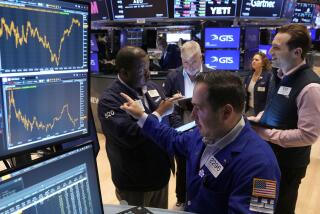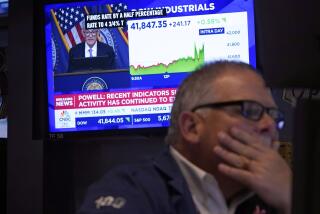Federal Reserve goes global in bid to stem credit crunch
WASHINGTON â In an act of global economic cooperation that echoed its response to the Sept. 11 terrorist attacks, the Federal Reserve on Wednesday announced an agreement with four foreign central banks to create a new method for injecting billions of dollars into the worldâs financial system to break up a potentially crippling logjam in credit.
The Fed said that it would lend at least $40 billion to cash-strapped U.S. banks starting next week and could supply considerably more. In addition, it will temporarily make $24 billion available to the European Central Bank and the Swiss National Bank to help meet demand for dollars in Europe.
By acting in conjunction with those institutions, as well as the Canadian and British central banks, the Fed is seeking to alleviate a problem that could hurt the United States as it struggles to avoid slipping into recession. The Fed also seeks to mitigate damage to the global economy -- especially at a time when rising U.S. exports are helping offset declines in the housing market.
The highly unusual step represents another attempt by central bank Chairman Ben S. Bernanke and his colleagues to cope with credit problems without continually paring interest rates. Some economists have blamed excessive rate-cutting for helping to fuel bubbles in stocks during the 1990s and housing during the first half of this decade.
The cooperation is not expected to have a serious effect on the value of the dollar, analysts said. In any case, federal policymakers believe a global credit crunch poses a greater danger to the American economy than a declining dollar.
Wednesdayâs action came after a string of interest rate cuts in the United States, Britain and Canada failed to bring down commercial rates and stimulate lending among banks that have become increasingly shy about making loans. Some economists fear that development may already have nudged the U.S. toward recession and a stalling of global economic growth.
By themselves, the Fed actions will not reverse slumping home prices or erase trouble with mortgage-backed securities that have fallen out of favor with investors because of the sub-prime home loan crisis. But analysts said that the concerted effort by the central banks would help the global financial system buy time to fix the problems on its own.
âYou want to face those problems in a calm world,â said Stephen G. Cecchetti, former research director with the New York Federal Reserve Bank and an economist with the Brandeis International Business School. âYou want to get the patient out of the emergency room before you take them on.â
Even as the Fed announced its plan, Bank of America Corp. and two other large U.S. banks warned of larger-than-expected write-downs this quarter because of problem loans.
The Fed acted one day after it trimmed its benchmark interest rate by a quarter of a point and a less-used rate by the same amount. The rate cuts disappointed investors, who considered them too little, too late, causing the stock market to tumble Tuesday. The market partially rebounded Wednesday.
A senior Fed official briefing reporters on background Wednesday asserted that investor ire played no role in the central bankâs new move. âMarket reaction [Tuesday] had nothing to do with todayâs announcement,â the official said. âThis has been in the works for a while. The market response [to the rate decision] was not a factor.â
In September, the Fed surprised the market by cutting the discount rate at which the central bank lends directly to commercial banks by half a point, a move aimed at encouraging such borrowing. Until then, so-called discount window borrowing was thought to carry a stigma and was rarely used by banks.
âThis Fed has surprised people with its ability to think outside the box,â said Jay H. Bryson, global economist for Wachovia Corp. âItâs trying to take a more targeted approach to financial problems, instead of the sledgehammerâ of cutting the benchmark federal funds rate.
In fact, the September experiment with the discount rate failed when few banks picked up on the offer. Wednesdayâs announcement can be viewed as a renewed attempt to encourage banks to make more use of direct loans from the central bank.
Under the current system, the chief way the Fed injects cash into the economy is through so-called open-market operations: The Fed makes short-term loans to 21 primary dealers, most of them big banks and investment houses that put up securities as collateral.
The primary dealers are then responsible for lending the money to the nationâs thousands of smaller banks.
But since last summer, big banks in the U.S. and abroad have found themselves increasingly burdened with mortgage-backed securities and other complex financial instruments that they had expected to sell but canât because of problems in the sub-prime market.
As a consequence, these banks have become increasingly unwilling to lend to other banks or have demanded steeply higher interest rates.
The result has been an abrupt evaporation of credit that has left many banks, businesses and consumers in the lurch.
In August, the Fed pumped $62 billion into the U.S. financial system in response to fears that too little money was available for lending, but that action did not represent the kind of systematic approach represented by Wednesdayâs announcement.
Under the new system, financially sound U.S. banks that are having trouble borrowing from big banks can go directly to the Fed and bid on funds they can keep for varying lengths of time. The bidding will be conducted in a series of four auctions.
As collateral, these banks can put up a wider, and riskier, array of securities -- not just Treasury issues.
The Fed said in a statement that the new system would be a more efficient way to ensure a more liquid market in difficult times. Officials said the central bank would consider making the system permanent.
âWhat I like most about the system is that he who needs the money the most gets to bid for it,â said Roger M. Kubarych, an economist at Unicredit Markets & Investment Banking.
The U.S central bank is seeking to accomplish a similar goal of knocking down interest rates and rekindling interbank lending with the so-called reciprocal swap lines, totaling $24 billion, that it is setting up with two foreign central banks.
A $20-billion line with the European Central Bank and a $4-billion one with the Swiss National Bank are designed to allow those institutions to make loans in dollars to banks in their jurisdictions.
The arrangements, under which the Fed would temporarily exchange dollars for euros or Swiss francs, will last for as long as six months.
âThe actions demonstrate that central banks are working together to try and forestall any prospective sharp tightening of credit conditions,â a Bank of England spokesman said, speaking on condition of anonymity.
After the Sept. 11 attacks, the Fed took a similar step by selling the European Central Bank $50 billion in U.S. currency.
--
Times staff writer Kim Murphy in London contributed to this report.
More to Read
Inside the business of entertainment
The Wide Shot brings you news, analysis and insights on everything from streaming wars to production â and what it all means for the future.
You may occasionally receive promotional content from the Los Angeles Times.










